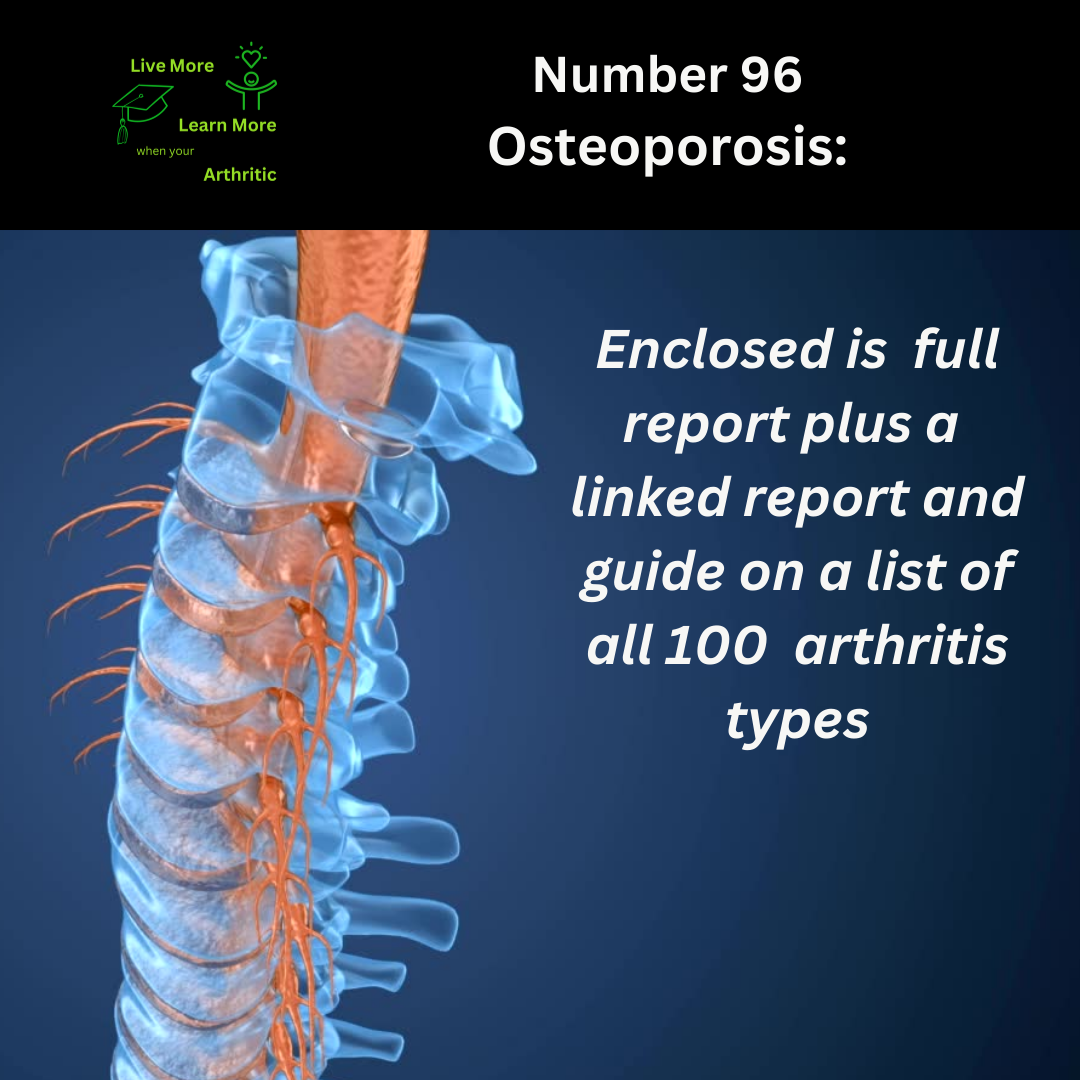
Osteoporosis: 96 on the list of 100 types of Arthritis
Understanding Osteoporosis: The Impact on Bone Health
Osteoporosis is a progressive bone disease characterized by reduced bone density and increased bone fragility, leading to a higher risk of fractures. It commonly affects certain parts of the body more than others, with the spine, hips, wrists, and ribs being among the most vulnerable.
 Description and Causes of Osteoporosis
Description and Causes of Osteoporosis
Osteoporosis develops when the process of bone remodeling becomes imbalanced, resulting in more bone resorption (breakdown) than bone formation. This can occur due to hormonal changes, particularly in postmenopausal women who experience a decrease in estrogen levels. Other causes include aging, inadequate dietary intake of calcium and vitamin D, sedentary lifestyle, smoking, excessive alcohol consumption, and certain medications (e.g., glucocorticoids).
Symptoms and Limited Range of Motion
In the early stages, osteoporosis often progresses silently without noticeable symptoms. However, as bone density decreases, individuals may experience symptoms such as back pain, loss of height due to vertebral compression fractures, and decreased range of motion in affected joints. Fractures, especially in the spine and hips, are common and can severely impact mobility and quality of life.
Age of Onset and Lifespan Impact
The age of onset for osteoporosis varies but is more common in older adults, particularly women over the age of 50. However, osteoporosis can also affect younger individuals with predisposing factors such as hormonal disorders or long-term medication use. While osteoporosis itself does not directly shorten lifespan, complications from fractures can contribute to reduced life expectancy, especially in older adults.
Risk Factors and Complications
Numerous risk factors contribute to the development of osteoporosis. These include advancing age, female sex, family history of osteoporosis, low body weight, sedentary lifestyle, smoking, excessive alcohol intake, and certain medical conditions such as rheumatoid arthritis, inflammatory bowel disease, and hyperthyroidism. Complications of osteoporosis include fractures (particularly of the spine, hip, and wrist), chronic pain, disability, and loss of independence.
Inflammation and Bone Health
While osteoporosis itself is not considered an inflammatory arthritis, chronic inflammation associated with other conditions like rheumatoid arthritis or inflammatory bowel disease can accelerate bone loss and increase fracture risk. Inflammatory cytokines released in these conditions disrupt normal bone remodeling, leading to excessive bone resorption.
Proactive Approaches and Quality of Life
Managing osteoporosis involves a proactive approach to preserve bone density and reduce fracture risk. Strategies include regular weight-bearing and muscle-strengthening exercises, adequate calcium and vitamin D intake through diet or supplements, smoking cessation, limiting alcohol consumption, fall prevention strategies (e.g., removing hazards at home), and medication therapy if indicated.
Possible Complications and Age Distribution
Complications of osteoporosis primarily revolve around fractures and their consequences, including chronic pain, reduced mobility, and loss of independence. Osteoporosis predominantly affects older adults, with women being more susceptible due to hormonal changes after menopause.
Interconnected Diseases and Conditions
Osteoporosis often coexists with other health conditions. For instance, individuals with inflammatory arthritis (e.g., rheumatoid arthritis) or gastrointestinal disorders (e.g., Crohn’s disease) are at higher risk due to chronic inflammation and potential malabsorption of nutrients vital for bone health. Diabetes, cardiovascular disease, and certain cancers can also influence bone density.
 Conclusion: Enhancing Quality of Life
Conclusion: Enhancing Quality of Life
In conclusion, while osteoporosis poses significant challenges, early detection and proactive management can greatly improve outcomes and quality of life. By addressing modifiable risk factors and adopting preventive measures, individuals can reduce the burden of osteoporosis and maintain bone health as they age.
This detailed exploration of osteoporosis underscores the importance of comprehensive management strategies to mitigate the impact of this condition on bone health and overall well-being.

